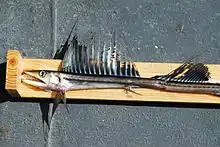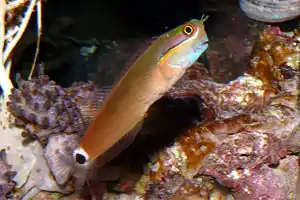Systematik der Knochenfische
Die folgende Systematik der rezenten Knochenfische (Osteichthyes) ist eines von zahlreichen vorhandenen Modellen zur Klassifikation der über 30.000 derzeit bekannten Knochenfisch-Arten, die heute auf der Erde leben. Sie folgt im Wesentlichen einer aktuellen Revision der Knochenfischsystematik, die im April 2013 veröffentlicht und im November 2013, im Juli 2014, 2016 sowie im Juli 2017 aktualisiert wurde (Betancur-R. et al., 2013, 2014, 2016, 2017; DeepFin.org).
Diese Revision ist das Ergebnis des Vergleichs der DNA-Sequenzen von 21 genetischen Markern (einem der Mitochondrialen DNA und 20 der Zellkern-DNA) von 1410 Knochenfischarten aus 1093 Gattungen, 369 Familien und allen traditionellen Ordnungen. Im Unterschied zu allen vorherigen Systematiken werden hier auch die problematischen Gruppen der Percomorpha (Barschverwandten) und Perciformes (Barschartigen) zu monophyletischen Taxa. Die Percomorpha können in acht gut begründete Taxa oberhalb des Ordnungsrangs unterteilt werden. Die Ordnung der Perciformes, bisher eine polyphyletische Sammelgruppe von über 10.000 Arten, über 1500 Gattungen, 160 Familien und 20 Unterordnungen barschähnlicher Fische (engl. „wastebag“-Taxon), wird erstmals zu einer monophyletischen Ordnung.
Die Knochenfische gliedern sich in zwei gut unterscheidbare Gruppen, die Fleischflosser (Sarcopterygii), von denen es nur noch acht rezente Arten gibt, aus denen aber die Landwirbeltiere (Tetrapoda) hervorgegangen sind, und die Strahlenflosser (Actinopterygii), zu denen über 95 % der heute lebenden Fischarten gehören. Ausgestorbene Gruppen sind in dieser Systematik bisher nicht berücksichtigt.
Fleischflosser (Sarcopterygii)
| Phylogenetische Systematik der basalen Knochenfische | |||||||||||||||||||||||||||||||||||||||||||||
|---|---|---|---|---|---|---|---|---|---|---|---|---|---|---|---|---|---|---|---|---|---|---|---|---|---|---|---|---|---|---|---|---|---|---|---|---|---|---|---|---|---|---|---|---|---|
|
- Klasse Coelacanthimorpha (= Actinistia)
- Ordnung Quastenflosser (Coelacanthiformes)
- Klasse Rhipidistia
- Unterklasse Lungenfische (Dipnomorpha)
- Ordnung Lungenfische (Ceratodontiformes)
- Australische Lungenfische (Neoceratodontidae)
- Südamerikanische Lungenfische (Lepidosirenidae)
- Afrikanische Lungenfische (Protopteridae)
- Ordnung Lungenfische (Ceratodontiformes)
- Unterklasse Lungenfische (Dipnomorpha)
Strahlenflosser (Actinopterygii)
- Klasse Cladistia
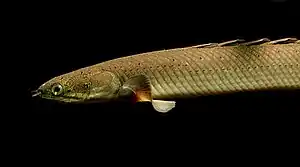 Senegal-Flösselhecht (Polypterus senegalus)
Senegal-Flösselhecht (Polypterus senegalus)- Ordnung Polypteriformes
- Familie Flösselhechte (Polypteridae)
- Ordnung Polypteriformes
- Klasse Actinopteri
- Unterklasse Knorpelganoiden (Chondrostei)
- Ordnung Störartige (Acipenseriformes)
- Störe (Acipenseridae)
- Löffelstöre (Polyodontidae)
- Ordnung Störartige (Acipenseriformes)
- Unterklasse Neopterygii
- Teilklasse Knochenganoiden (Holostei)
- Ordnung Amiiformes
- Ordnung Knochenhechtartige (Lepisosteiformes)
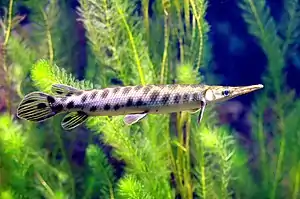 Gefleckter Knochenhecht (Lepisosteus oculatus)
Gefleckter Knochenhecht (Lepisosteus oculatus)- Knochenhechte (Lepisosteidae)
- Teilklasse Echte Knochenfische (Teleostei)
- Megakohorte Elopocephalai sensu Arratia[1]
- Kohorte Elopomorpha
- Ordnung Tarpunartige (Elopiformes)
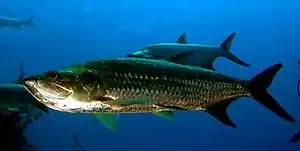 Atlantischer Tarpun (Megalops atlanticus)
Atlantischer Tarpun (Megalops atlanticus)- Frauenfische (Elopidae)
- Tarpune (Megalopidae)
- Ordnung Grätenfischartige (Albuliformes)
- Grätenfische (Albulidae)
- Ordnung Dornrückenaalartige (Notacanthiformes)
- Echsenaale (Halosauridae)
- Dornrückenaale (Notacanthidae)
- Ordnung Aalartige (Anguilliformes)
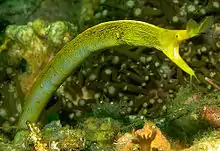 Geistermuräne (Rhinomuraena quaesita)
Geistermuräne (Rhinomuraena quaesita)- Protanguillidae
- Pelikanaale (Eurypharyngidae)
- Sackmäuler (Saccopharyngidae)
- Flussaale (Anguillidae)
- Schnepfenaale (Nemichthyidae)
- Muränen (Muraenidae)
- Sägezahn-Schnepfenaale (Serrivomeridae)
- Meeraale (Congridae)
- Hechtconger (Muraenesocidae)
- Schlangenaale (Ophichthidae)
- Heterenchelyidae
- Wurmaale (Moringuidae)
- Chlopsidae
- Myrocongridae
- Grubenaale (Synaphobranchidae)
- Langhalsaale (Derichthyidae)
- Entenschnabelaale (Nettastomatidae)
- Cyematidae
- Neocyematidae
- Einkieferaale (Monognathidae)
- Ordnung Tarpunartige (Elopiformes)
- Kohorte Elopomorpha
- Megakohorte Osteoglossocephalai (= Osteoglossocephala sensu Arratia[1])
- Überkohorte Knochenzünglerähnliche (Osteoglossomorpha)
 Arapaima (Arapaima gigas)
Arapaima (Arapaima gigas)- Ordnung Hiodontiformes
- Mondaugen (Hiodontidae)
- Ordnung Knochenzünglerartige (Osteoglossiformes)
- Schmetterlingsfisch (Pantodontidae)
- Knochenzüngler (Osteoglossidae)
- Arapaimidae
- Großnilhecht (Gymnarchidae)
- Nilhechte (Mormyridae)
- Altwelt-Messerfische (Notopteridae)
- Ordnung Hiodontiformes
- Überkohorte Clupeocephala
- Kohorte Otomorpha (= Otocephala, Ostarioclupeomorpha)
- Unterkohorte Clupei
 Atlantischer Hering (Clupea harengus)
Atlantischer Hering (Clupea harengus)- Ordnung Heringsartige (Clupeiformes)
- Unterordnung Denticipitoidei
- Zähnchen-Heringe (Denticipitidae)
- Unterordnung Clupeoidei
- Wolfsheringe (Chirocentridae)
- Heringe (Clupeidae)
- Rundheringe (Dussumieriidae)
- Sardellen (Engraulidae)
- Beilbauchheringe (Pristigasteridae)
- Spratelloididae[2]
- Unterordnung Denticipitoidei
- Ordnung Heringsartige (Clupeiformes)
- Unterkohorte Alepocephali
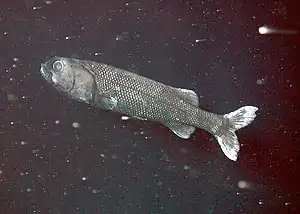 Alepocephalus tenebrosus
Alepocephalus tenebrosus- Ordnung Alepocephaliformes
- Schwarzköpfe (Alepocephalidae)
- Leuchtheringe (Platytroctidae)
- Ordnung Alepocephaliformes
- Unterkohorte Ostariophysi
- Sektion Anotophysa
- Ordnung Sandfischartige (Gonorynchiformes)
- Sandfische (Gonorynchidae)
- Milchfische (Chanidae)
- Schlankfische (Kneriidae)
- Ordnung Sandfischartige (Gonorynchiformes)
- Sektion Otophysa
- Überordnung Cypriniphysae
- Ordnung Karpfenartige (Cypriniformes)
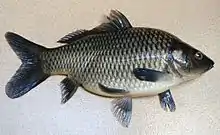 Karpfen (Cyprinus carpio)
Karpfen (Cyprinus carpio)- Überfamilie Schmerlenartige (Cobitoidea)
- Saugkarpfen (Catostomidae)
- Saugschmerlen (Gyrinocheilidae)
- Steinbeißer (Cobitidae)
- Plattschmerlen (Balitoridae)
- Prachtschmerlen (Botiidae)[3][4][5]
- Bachschmerlen (Nemacheilidae)[3][4][5]
- Vaillantellidae[3][4][5]
- Gastromyzontidae[6]
- Ellopostomatidae[4][5]
- Barbuccidae[6]
- Serpenticobitidae[6]
- Überfamilie Karpfenfischähnliche (Cyprinoidea)
- Spindelschmerlen (Psilorhynchidae)
- Paedocyprididae
- Karpfenfische (Cyprinidae)
- Sundadanionidae
- Bärblinge (Danionidae)
- Leptobarbidae
- Xenocyprididae
- Schleie (Tincidae)
- Bitterlinge (Acheilognathidae)
- Gründlingsverwandte (Gobionidae)
- Kardinalfische (Tanichthyidae)
- Weißfische (Leuciscidae)
- Überfamilie Schmerlenartige (Cobitoidea)
- Ordnung Karpfenartige (Cypriniformes)
- Überordnung Characiphysae
- Ordnung Salmlerartige (Characiformes)
 Roter Neon (Paracheirodon axelrodi)
Roter Neon (Paracheirodon axelrodi)- Unterordnung Geradsalmler (Citharinoidei)
- Eigentliche Geradsalmler (Citharinidae)
- Distichodontidae
- Unterordnung Characoidei
- Kopfsteher (Chilodontidae)
- Engmaulsalmler (Anostomidae)
- Breitlingssalmler (Curimatidae)
- Amerikanische Hechtsalmler (Ctenoluciidae)
- Pracht- und Bodensalmler (Crenuchidae)
- Afrikanische Salmler (Alestidae)
- Afrikanische Hechtsalmler (Hepsetidae)
- Raubsalmler (Erythrinidae)
- Tarumaniidae
- Wolfssalmler (Cynodontidae)
- Sägesalmler (Serrasalmidae)
- Algensalmler (Parodontidae)
- Keulensalmler (Hemiodontidae)
- Barbensalmler (Prochilodontidae)
- Schlanksalmler (Lebiasinidae)
- Chalceidae
- Bryconidae
- Iguanodectidae
- Triportheidae
- Echte Salmler (Characidae)
- Beilbauchsalmler (Gasteropelecidae)
- Acestrorhynchidae
- Unterordnung Geradsalmler (Citharinoidei)
- Ordnung Salmlerartige (Characiformes)
- Überordnung Siluriphysae
- Ordnung Neuwelt-Messerfische (Gymnotiformes)
 Zitteraal (Electrophorus electricus)
Zitteraal (Electrophorus electricus)- Messeraale (Gymnotidae)
- Schwanzflossen-Messeraale (Apteronotidae)
- Glasmesserfische (Sternopygidae)
- Sand-Messeraale (Rhamphichthyidae)
- Kleine Messerfische (Hypopomidae)
- Ordnung Welsartige (Siluriformes)
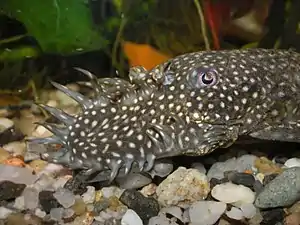 Kopf eines Antennen-Harnischwels (Ancistrus sp.)
Kopf eines Antennen-Harnischwels (Ancistrus sp.)- Kryptoglanidae
- Unterordnung Loricarioidei
- Nematogenyidae
- Schmerlenwelse (Trichomycteridae)
- Harnischwelse (Loricariidae)
- Kletterwelse (Astroblepidae)
- Stachlige Zwergwelse (Scoloplacidae)
- Panzer- und Schwielenwelse (Callichthyidae)
- Unterordnung Diplomystoidei
- Primitivwelse (Diplomystidae)
- Unterordnung Siluroidei
 Hemibagrus wyckioides
Hemibagrus wyckioides- Gebirgswelse (Sisoridae)
- Flusswelse (Akysidae)
- Schlankwelse (Amblycipitidae)
- Stachelwelse (Bagridae)
- Ritidae
- Afrikanische Glaswelse (Schilbeidae)
- Ailiidae
- Horabagridae
- Heteropneustidae
- Kiemensackwelse (Clariidae)
- Großmaulwelse (Chacidae)
- Walwelse (Cetopsidae)
- Panzerkopfwelse (Cranoglanididae)
- Katzenwelse (Ictaluridae)
- Haiwelse (Pangasiidae)
- Anchariidae
- Kreuzwelse (Ariidae)
- Claroteidae
- Quappenwelse (Amphiliidae)
- Elektrische Welse (Malapteruridae)
- Fiederbartwelse (Mochokidae)
- Echte Welse (Siluridae)
- Aal- und Korallenwelse (Plotosidae)
- Dornwelse (Doradidae)
- Falsche Dornwelse (Auchenipteridae)
- Phreatobiidae
- Heptapteridae
- Großmaul-Antennenwelse (Pseudopimelodidae)
- Antennenwelse (Pimelodidae)
- Austroglanididae
- Erethistidae
- Bratpfannen- und Banjowelse (Aspredinidae)
- Lacantuniidae
- Ordnung Neuwelt-Messerfische (Gymnotiformes)
- Überordnung Cypriniphysae
- Sektion Anotophysa
- Unterkohorte Clupei
- Kohorte Euteleosteomorpha
- Ordnung Lepidogalaxiiformes
- Salamanderfisch (Lepidogalaxiidae)
- Ordnung Galaxiiformes
- Galaxien (Galaxiidae)
- Ordnung Goldlachsartige (Argentiniformes)
- Tiefseestinte (Bathylagidae)
- Microstomatidae
- Gespensterfische (Opisthoproctidae)
- Goldlachse (Argentinidae)
- Ordnung Lachsartige (Salmoniformes)
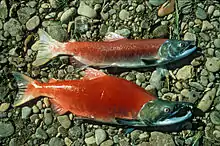 Rotlachs (Oncorhynchus nerka)
Rotlachs (Oncorhynchus nerka)- Lachsfische (Salmonidae)
- Ordnung Hechtartige (Esociformes)
- Hundsfische (Umbridae)
- Hechte (Esocidae)
- ohne Rang Stomiati
- Ordnung Maulstachler (Stomiiformes)
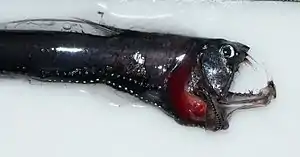 Pazifischer Viperfisch (Chauliodus macouni)
Pazifischer Viperfisch (Chauliodus macouni)- Borstenmäuler (Gonostomatidae)
- Leuchtfische (Phosichthyidae)
- Barten-Drachenfische (Stomiidae)
- Tiefsee-Beilfische (Sternoptychidae)
- Ordnung Stintartige (Osmeriformes)
- Neuseelandlachse (Retropinnidae)
- Stinte (Osmeridae)
- Plecoglossidae
- Salangidae
- Ordnung Maulstachler (Stomiiformes)
- Unterkohorte Neoteleostei
- Ordnung Ateleopodiformes
- Tiefseequappen (Ateleopodidae)
- Ordnung Eidechsenfischverwandte (Aulopiformes)
- Unterordnung Aulopoidei
- Eidechsenfische (Synodontidae)
- Flaggenflosser (Aulopidae)
- Pseudotrichonotidae
- Unterordnung Paraulopoidei
- Unterordnung Alepisauroidei
- Teleskopfische (Giganturidae)
- Tiefsee-Eidechsenfische (Bathysauridae)
- Netzaugenfische (Ipnopidae)
- Perlaugen (Scopelarchidae)
- Notosudidae
- Grünaugen (Chlorophthalmidae)
- Barrakudinas (Paralepididae)
- Säbelzahnfische (Evermannellidae)
- Sudidae
- Alepisauridae
- Bathysauroididae
- Lestidiidae
- Unterordnung Aulopoidei
- Ordnung Laternenfischartige (Myctophiformes)
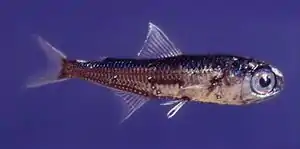 Schlankschwänziger Laternenfisch (Myctophum punctatum)
Schlankschwänziger Laternenfisch (Myctophum punctatum)- Laternenfische (Myctophidae)
- Laternenzüngler (Neoscopelidae)
- Acanthomorphata
- Division Lampripterygii
- Ordnung Glanzfischartige (Lampriformes)
- Segelträger (Veliferidae)
- Gotteslachse (Lampridae)
- Schopffische (Lophotidae)
- Strahlenköpfe (Radiicephalidae)
- Riemenfische (Regalecidae)
- Sensenfische (Trachipteridae)
- Ordnung Glanzfischartige (Lampriformes)
- Division Paracanthopterygii (sensu Grande et al.[7])
- Ordnung Bartfischartige (Polymixiiformes)
- Bartfische (Polymixiidae)
- Serie Percopsaria
- Ordnung Barschlachsartige (Percopsiformes)
- Blindfische (Amblyopsidae)
- Piratenbarsche (Aphredoderidae)
- Barschlachse (Percopsidae)
- Ordnung Barschlachsartige (Percopsiformes)
- Serie Zeiogadaria (= Zeioigadiformes sensu Li et al.[8])
- Unterserie Zeiariae
- Ordnung Petersfischartige (Zeiformes)
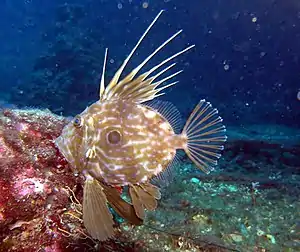 Petersfisch (Zeus faber)
Petersfisch (Zeus faber)
- Ordnung Petersfischartige (Zeiformes)
- Unterserie Gadariae
- Ordnung Stylephoriformes (sensu Miya et al.[9])
- Ordnung Dorschartige (Gadiformes)[10]
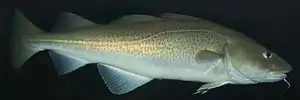 Kabeljau (Gadus morhua)
Kabeljau (Gadus morhua)- Unterordnung Bregmacerotoidei
- Einhorndorsche (Bregmacerotidae)
- Unterordnung Gadoidei
- Gabeldorsche (Phycidae)
- Gaidropsaridae
- Quappen (Lotidae)
- Dorsche (Gadidae)
- Unterordnung Ranicipitoidei
- Froschdorsche (Ranicipitidae)
- Unterordnung Merluccioidei
- Seehechte (Merlucciidae)
- Unterordnung Macrouroidei
- Trachyrincidae
- Euclichthyidae
- Aaldorsche (Muraenolepididae)
- Hochseedorsche (Melanonidae)
- Tiefseedorsche (Moridae)
- Bathygadidae
- Lyconidae
- Macruronidae
- Leuchtseehechte (Steindachneriidae)
- Grenadierfische (Macrouridae)
- Unterordnung Bregmacerotoidei
- Unterserie Zeiariae
- Ordnung Bartfischartige (Polymixiiformes)
- Division Stachelflosser (Acanthopterygii)
- Unterdivision Berycimorphaceae
- Ordnung Schleimkopfartige (Beryciformes)
- Schleimköpfe (Berycidae)
- Großschuppenfische (Melamphaidae)
- Barbourisiidae
- Rotmäulige Walkopffische (Rondeletiidae)
- Walköpfe (Cetomimidae)
- Gibberichthyidae
- Hispidoberycidae
- Dornfische (Stephanoberycidae)
- Ordnung Trachichthyiformes
 Anoplogaster cornuta
Anoplogaster cornuta- Laternenträger (Anomalopidae)
- Fangzahnfische (Anoplogastridae)
- Silberköpfe (Diretmidae)
- Tannenzapfenfische (Monocentridae)
- Sägebäuche (Trachichthyidae)
- Ordnung Schleimkopfartige (Beryciformes)
- Unterdivision Holocentrimorphaceae
- Ordnung Holocentriformes
- Soldaten- und Husarenfische (Holocentridae)[11][12]
- Ordnung Holocentriformes
- Unterdivision Barschverwandte (Percomorphaceae)
- Serie Ophidiaria
- Ordnung Eingeweidefischartige (Ophidiiformes)
- Unterordnung Ophidioidei
- Bartmännchen (Ophidiidae)
- Eingeweidefische (Carapidae)
- Unterordnung Bythitoidei
- Lebendgebärende Brotulas (Bythitidae)
- Dinematichthyidae[13]
- Unterordnung Ophidioidei
- Ordnung Eingeweidefischartige (Ophidiiformes)
- Serie Batrachoidaria
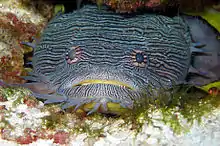 Korallen-Krötenfisch (Sanopus splendidus)
Korallen-Krötenfisch (Sanopus splendidus)- Ordnung Batrachoidiformes
- Froschfische (Batrachoididae)
- Ordnung Batrachoidiformes
- Serie Gobiaria[14]
- Ordnung Kurterartige (Kurtiformes)
- Unterordnung Kurtoidei
- Kurter (Kurtidae)
- Unterordnung Apogonoidei
- Kardinalbarsche (Apogonidae)
- Unterordnung Kurtoidei
- Ordnung Grundelartige (Gobiiformes)
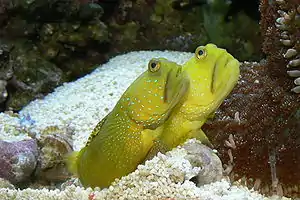 Gelbe Symbiosegrundeln (Cryptocentrus cinctus)
Gelbe Symbiosegrundeln (Cryptocentrus cinctus)- Sandtaucher (Trichonotidae)
- Schmerlengrundeln (Rhyacichthyidae)
- Zahn-Schläfergrundeln (Odontobutidae)
- Milyeringidae[15]
- Butidae
- Schläfergrundeln (Eleotridae)
- Oxudercidae
- Thalasseleotrididae
- Grundeln (Gobiidae)
- Ordnung Kurterartige (Kurtiformes)
- Serie Syngnatharia
- Ordnung Seenadelartige (Syngnathiformes)[16]
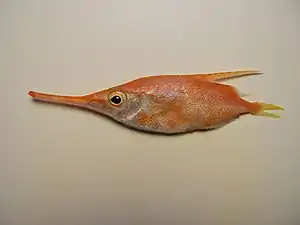 Schlanker Schnepfenfisch (Macroramphosus gracilis)
Schlanker Schnepfenfisch (Macroramphosus gracilis)- Unterordnung Syngnathoidei
- Trompetenfische (Aulostomidae)
- Schnepfenfische (Centriscidae)
- Flötenfische (Fistulariidae)
- Geisterpfeifenfische (Solenostomidae)
- Seenadeln (Syngnathidae)
- Unterordnung Dactylopteroidei
- Flughähne (Dactylopteridae)
- Flügelrossfische (Pegasidae)
- Unterordnung Leierfischartige (Callionymoidei)
- Leierfische (Callionymidae)
- Drachenleierfische (Draconettidae)
- Unterordnung Mulloidei
- Meerbarben (Mullidae)
- Unterordnung Syngnathoidei
- Ordnung Seenadelartige (Syngnathiformes)[16]
- Serie Pelagiaria
- Ordnung Scombriformes (= Stromateoidei sensu Li et al.[8], = Pelagia sensu Miya et al.[17])
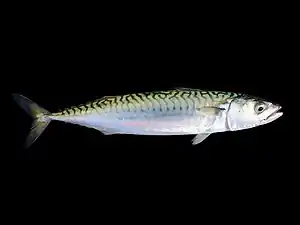 Makrele (Scomber scombrus)
Makrele (Scomber scombrus)- Schwarzfische (Centrolophidae)
- Galeerenfische (Nomeidae)
- Driftfische (Ariommatidae)
- Schwarze Schlinger (Chiasmodontidae)
- Schlangenmakrelen (Gempylidae)
- Haarschwänze (Trichiuridae)
- Icosteidae
- Medusenfische (Stromateidae)
- Seebrassen (Bramidae)
- Makrelen und Thunfische (Scombridae)
- Pomatomidae
- Mähnenbarsche (Caristiidae)
- Scombrolabracidae
- Amarsipidae
- Quadratschwänze (Tetragonuridae)
- Lachsbarsche (Arripidae)
- Ordnung Scombriformes (= Stromateoidei sensu Li et al.[8], = Pelagia sensu Miya et al.[17])
- Serie Anabantaria (= Anabantiformes sensu Li et al.[8])
- Ordnung Kiemenschlitzaalartige (Synbranchiformes)
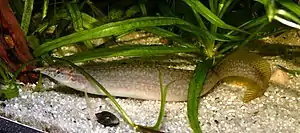 Indischer Zwergstachelaal (Macrognathus pancalus)
Indischer Zwergstachelaal (Macrognathus pancalus)- Unterordnung Indostomoidei
- Unterordnung Synbranchoidei
- Kiemenschlitzaale (Synbranchidae)
- Unterordnung Mastacembeloidei
- Stachelaale (Mastacembelidae)
- Chaudhuriidae
- Ordnung Kletterfischartige (Anabantiformes)
- Unterordnung Labyrinthfische (Anabantoidei)
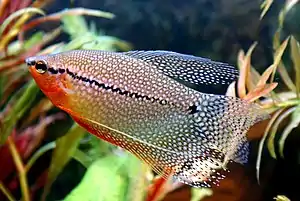 Mosaikfadenfisch (Trichopodus leerii)
Mosaikfadenfisch (Trichopodus leerii)- Osphronemidae
- Helostomatidae
- Kletterfische und Buschfische (Anabantidae)
- Unterordnung Channoidei
- Aenigmachannidae[18]
- Schlangenkopffische (Channidae)
- Unterordnung Nandoidei
- Blaubarsche (Badidae)
- Nanderbarsche (Nandidae)
- Sägeschuppenbarsche (Pristolepididae)
- Unterordnung Labyrinthfische (Anabantoidei)
- Ordnung Kiemenschlitzaalartige (Synbranchiformes)
- Serie Carangaria (= Carangimorpha sensu Li et al.[8])
- Ordnung Carangiformes[19]
- Unterordnung Centropomoidei
- Riesenbarsche (Latidae)
- Centropomidae
- Lactariidae
- Barrakudas (Sphyraenidae)
- Unterordnung Polynemoidei
- Fadenflosser (Polynemidae)
- Teilordnung Plattfische (Pleuronectoideo)
- Psettodidae
- Leierplattfische (Citharidae)
- Steinbutte (Scophthalmidae)
- Butte (Bothidae)
- Cyclopsettidae
- Paralichthyidae
- Schollen (Pleuronectidae)
- Amerikanische Seezungen (Achiridae)
- Paralichthodidae
- Rhombosoleidae
- Südflundern (Achiropsettidae)
- Oncopteridae
- Kamm-Flundern (Samaridae)
- Poecilopsettidae
- Seezungen (Soleidae)
- Hundszungen (Cynoglossidae)
- Unterordnung Toxotoidei
- Leptobramidae
- Schützenfische (Toxotidae)
- Unterordnung Nematistioidei
- Unterordnung Menoidei
- Mondbarsche (Menidae)
- Überfamilie Schwertfischverwandte (Xiphioidea)
- Schwertfische (Xiphiidae)
- Speerfische (Istiophoridae)
- Unterordnung Stachelmakrelenverwandte (Carangoidei)
- Stachelmakrelen (Carangidae)
- Überfamilie Echeneoidea
- Schiffshalter (Echeneidae)
- Cobia (Rachycentridae)
- Goldmakrelen (Coryphaenidae)
- Unterordnung Centropomoidei
- Ordnung Carangiformes[19]
- Serie Ovalentaria (sensu Smith & Near in Wainwright et al.; = Stiassnyiformes sensu Li et al.[8])
- Incertae sedis
- Glasbarsche (Ambassidae)
- Aalbarsche (Congrogadidae)
- Brandungsbarsche (Embiotocidae)
- Feenbarsche (Grammatidae)
- Kieferfische (Opistognathidae)
- Mirakelbarsche (Plesiopidae)
- Vielstachler (Polycentridae)
- Riffbarsche (Pomacentridae)
- Zwergbarsche (Pseudochromidae)
- Ordnung Buntbarschartige (Cichliformes)
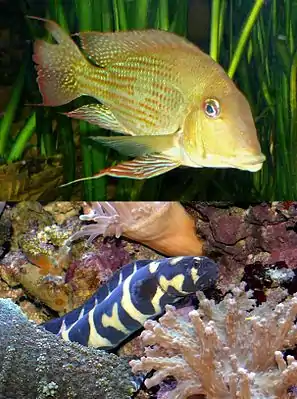 En Buntbarsch aus der Gattung Geophagus und Pholidichthys leucotaenia
En Buntbarsch aus der Gattung Geophagus und Pholidichthys leucotaenia- Buntbarsche (Cichlidae)
- Pholidichthyidae
- Überordnung Ährenfischverwandte (Atherinomorphae)
- Ordnung Ährenfischartige (Atheriniformes)
- Neuweltliche Ährenfische (Atherinopsidae)
- Altweltliche Ährenfische (Atherinidae)
- Atherionidae
- Regenbogenfische (Melanotaeniidae)
- Madagassische Ährenfische (Bedotiidae)
- Blauaugen (Pseudomugilidae)
- Sonnenstrahlenfische (Telmatherinidae)
- Kehlphallusfische (Phallostethidae)
- Isonidae
- Dentatherinidae
- Ordnung Hornhechtartige (Beloniformes)
- Unterordnung Adrianichthyoidei
- Reisfische (Adrianichthyidae)
- Unterordnung Belonoidei
- Hornhechte (Belonidae)
- Fliegende Fische (Exocoetidae)
- Zenarchopteridae
- Halbschnäbler (Hemiramphidae)
- Unterordnung Adrianichthyoidei
- Ordnung Zahnkärpflinge (Cyprinodontiformes)
- Unterordnung Aplocheiloidei
- Unterordnung Cyprinodontoidei
- Aphaniidae
- Anablepidae
- Cubanichthyidae
- Cyprinodontidae
- Hochlandkärpflinge (Goodeidae)
- Südamerikanische Leuchtaugenfische (Fluviphylacidae)
- Fundulidae
- Andenkärpflinge (Orestiidae)
- Pantanodontidae
- Lebendgebärende Zahnkarpfen (Poeciliidae)
- Leuchtaugenfische (Procatopodidae)
- Profundulidae
- Valenciidae
- Ordnung Ährenfischartige (Atheriniformes)
- Überordnung Mugilomorphae
- Ordnung Mugiliformes
- Meeräschen (Mugilidae)
- Ordnung Mugiliformes
- Überordnung Blenniimorphae
- Ordnung Gobiesociformes
- Schildfische (Gobiesocidae)
- Ordnung Schleimfischartige (Blenniiformes)
- Schleimfische (Blenniidae)
- Sandsterngucker (Dactyloscopidae)
- Beschuppte Schleimfische (Labrisomidae)
- Klippfische (Clinidae)
- Hechtschleimfische (Chaenopsidae)
- Dreiflossen-Schleimfische (Tripterygiidae)
- Ordnung Gobiesociformes
- Incertae sedis
- Serie Eupercaria
- Incertae sedis (Familien, die traditionell den „Perciformes“ zugeordnet werden)
- Glanzbarsche (Callanthiidae)
- Centrogenyidae
- Spaltenbarsche (Dinopercidae)
- Emmelichthyidae
- Torpedobarsche (Malacanthidae)
- Ziegelbarsche (Latilidae)
- Flossenblätter (Monodactylidae)
- Wolfsbarsche (Moronidae)
- Umberfische (Sciaenidae)
- Sillaginidae
- Ordnung Gerreiformes
- Mojarras (Gerreidae)
- Ordnung Himmelsguckerartige (Uranoscopiformes = Paratrachiniformes sensu Li et al.[8])
- Himmelsgucker (Uranoscopidae)
- Sandaale (Ammodytidae)
- Sandbarsche (Pinguipedidae)
- Cheimarrichthyidae
- Schlankhimmelsgucker (Leptoscopidae)[20]
- Ordnung Labriformes
- Lippfische (Labridae) (nur incl. Odacidae + Scaridae monophyletisch)
- Ordnung Doktorfischartige (Acanthuriformes)[21]
- Doktorfische (Acanthuridae)
- Antigoniidae
- Caproidae
- Falterfische (Chaetodontidae)
- Sichelfische (Drepaneidae)
- Spatenfische (Ephippidae)
- Ponyfische (Leiognathidae)
- Lobotidae
- Luvaridae
- Kaiserfische (Pomacanthidae)
- Argusfische (Scatophagidae)
- Kaninchenfische (Siganidae)
- Zanclidae
- Ordnung Lutjaniformes
- Süßlippen und Grunzer (Haemulidae)
- Schnapper (Lutjanidae)
- Ordnung Meerbrassenartige (Spariformes)sensu Akazaki[22][23]
- Großkopfschnapper (Lethrinidae)
- Meerbrassen (Sparidae)
- Scheinschnapper (Nemipteridae)
- Ordnung Priacanthiformes
- Bandfische (Cepolidae)
- Großaugenbarsche (Priacanthidae)
- Ordnung Armflosser (Lophiiformes)[24]
- Unterordnung Lophioidei
- Seeteufel (Lophiidae)
- Unterordnung Antennarioidei
- Anglerfische (Antennariidae)
- Handfische oder Warzen-Angler (Brachionichthyidae)
- Lophichthyidae
- Tetrabrachiidae
- Unterordnung Chaunacoidei
- Seekröten (Chaunacidae)
- Unterordnung Ogcocephaloidei
- Seefledermäuse (Ogcocephalidae)
- Unterordnung Tiefsee-Anglerfische (Ceratioidei)
- Fächerflosser (Caulophrynidae)
- Rutenangler (Ceratiidae)
- Peitschennasen-Angler (Gigantactinidae)
- Peitschenangler (Himantolophidae)
- Schwarzangler (Melanocetidae)
- Oneirodidae
- Neoceratiidae
- Doppelanglerfische (Diceratiidae)
- Thaumatichthyidae
- Centrophrynidae
- Teufelsangler (Linophrynidae)
- Unterordnung Lophioidei
- Ordnung Kugelfischverwandte (Tetraodontiformes)
 Seegras-Feilenfisch (Acreichthys tomentosus)
Seegras-Feilenfisch (Acreichthys tomentosus)- Unterordnung Triacanthodoidei
- Hornfische (Triacanthodidae)
- Unterordnung Triacanthoidei
- Dreistachler (Triacanthidae)
- Unterordnung Tetraodontoidei
- Igelfische (Diodontidae)
- Kugelfische (Tetraodontidae)
- Unterordnung Moloidei
- Mondfische (Molidae)
- Unterordnung Balistoidei
- Feilenfische (Monacanthidae)
- Drückerfische (Balistidae)
- Unterordnung Ostracioidei
- Kofferfische (Ostraciidae)
- Aracanidae
- Unterordnung Triodontoidei
- Dreizahn-Kugelfisch (Triodontidae)
- Unterordnung Triacanthodoidei
- Ordnung Acropomatiformes bzw. Pempheriformes[25]
- Acropomatidae
- Banjofische (Banjosidae)
- Tiefseeheringe (Bathyclupeidae)[26]
- Krokodilzahnfische (Champsodontidae)
- Tiefsee-Kardinalbarsche (Epigonidae)
- Sandhöhlenfische (Creediidae)
- Langflossenhecht (Dinolestidae)[25]
- Hemerocoetidae
- Perlbarsche (Glaucosomatidae)
- Howellidae
- Lateolabracidae
- Malakichthyidae[25]
- Ostracoberycidae
- Glas- oder Beilfische (Pempheridae)[27]
- Panzerköpfe (Pentacerotidae)
- Wrackbarsche (Polyprionidae)
- Gnomenfische (Scombropidae)[25]
- Symphysanodontidae[26]
- Synagropidae[25]
- Ordnung Centrarchiformes
- Unterordnung Centrarchoidei
- Sonnenbarsche (Centrarchidae)
- Zwergschwarzbarsche (Elassomatidae)
- Sinipercidae
- Doppel-Rückenflosser (Enoplosidae)
- Unterordnung Percichthyoidei
- Dorschbarsche (Percichthyidae)
- Unterordnung Büschelbarschartige (Cirrhitioidei)
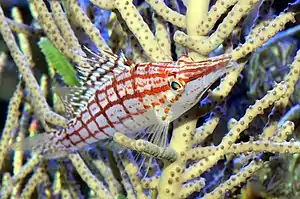 Langschnauzen-Korallenwächter (Oxycirrhites typus)
Langschnauzen-Korallenwächter (Oxycirrhites typus)- Cheilodactylidae
- Büschelbarsche (Cirrhitidae)
- Marmorfische (Aplodactylidae)
- Kelpfische (Chironemidae)
- Latridae
- Unterordnung Percalatoidei
- Unterordnung Terapontoidei
- Galeonenbarsche (Dichistiidae)[26]
- Nagebarsche (Girellidae)
- Flaggenschwänze (Kuhliidae)
- Steuerbarsche (Kyphosidae)
- Schnabelbarsche (Oplegnathidae)
- Grunzbarsche (Terapontidae)
- Unterordnung Centrarchoidei
- Ordnung Barschartige (Perciformes)(= Serraniformes sensu Li et al.[8][28])
- Sägebarsche (Serranidae)
- Fahnenbarsche (Anthiadidae)[29]
- Caesioscorpididae[30]
- Hemilutjanidae[30]
- Zackenbarsche (Epinephelidae)
- Seifenbarsche (Grammistidae)[29]
- Liopropomatidae[29]
- Unterordnung Percoidei
- Niphonidae
- Echte Barsche (Percidae)
- Petermännchen (Trachinidae)[28]
- Unterordnung Bembropoidei
- Unterordnung Congiopodoidei
- Schweinsfische (Congiopodidae)
- Zanclorhynchidae
- Unterordnung Normanichthyoidei
- Schuppengroppe (Normanichthyidae)
- Unterordnung Antarktisfische (Notothenioidei)
- Percophidae
- Pseudaphritidae
- Eleginopsidae
- Antarktisdorsche (Nototheniidae)
- Artedidraconidae
- Antarktisraubfische (Harpagiferidae)
- Antarktisdrachenfische (Bathydraconidae)
- Krokodileisfische (Channichthyidae)
- Eisfische (Bovichtidae)
- Unterordnung Scorpaenoidei
- Stachel-Flachköpfe (Hoplichthyidae)
- Sprottenflachköpfe (Parabembridae)
- Plattköpfe (Platycephalidae)
- Knurrhähne (Triglidae)
- Tiefsee-Plattköpfe (Bembridae)
- Neosebastidae
- Plectrogeniidae
- Drachenköpfe (Scorpaenidae)
- Synanceiidae (Steinfische und Verwandte)
- Unterordnung Cottoidei (= Cottimorpha sensu Li et al.[8])
- Teilordnung Anoplopomatales
- Skilfische (Anoplopomatidae)
- Teilordnung Stichlingsartige (Gasterosteales)
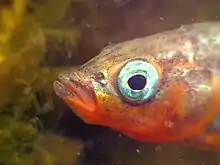 Dreistachliger Stichling (Gasterosteus aculeatus)
Dreistachliger Stichling (Gasterosteus aculeatus)- Stichlinge (Gasterosteidae)
- Hypoptychidae
- Aulorhynchidae
- Teilordnung Aalmutterverwandte (Zoarcales)
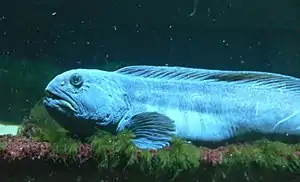 Blauer Seewolf (Anarhichas dentaculatus)
Blauer Seewolf (Anarhichas dentaculatus)- Ronquils (Bathymasteridae)
- Cebidichthyidae
- Stachelrücken (Stichaeidae)
- Zaproridae
- Schiefmäuler (Cryptacanthodidae)
- Butterfische (Pholidae)
- Seewölfe (Anarhichadidae)
- Aalmuttern (Zoarcidae)
- Eulophiidae
- Ptilichthyidae
- Scytalinidae
- Schlangenstachelrücken (Lumpenidae)
- Neozoarcidae
- Opisthocentridae
- Teilordnung Hexagrammales
- Grünlinge (Hexagrammidae)
- Teilordnung Zaniolepidoales
- Teilordnung Groppenverwandte (Cottales)
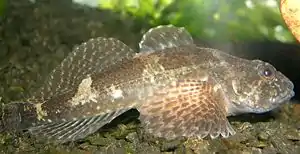 Groppe (Cottus gobio)
Groppe (Cottus gobio)- Panzergroppen (Agonidae)
- Groppen (Cottidae)
- Seehasen (Cyclopteridae)
- Jordaniidae
- Scheibenbäuche (Liparidae)
- Dickkopf-Groppen (Psychrolutidae)
- Rhamphocottidae
- Scorpaenichthyidae
- Trichodontidae
- Teilordnung Anoplopomatales
- Incertae sedis (Familien, die traditionell den „Perciformes“ zugeordnet werden)
- Serie Ophidiaria
- Unterdivision Berycimorphaceae
- Division Lampripterygii
- Ordnung Ateleopodiformes
- Ordnung Lepidogalaxiiformes
- Kohorte Otomorpha (= Otocephala, Ostarioclupeomorpha)
- Überkohorte Knochenzünglerähnliche (Osteoglossomorpha)
- Megakohorte Elopocephalai sensu Arratia[1]
- Teilklasse Knochenganoiden (Holostei)
- Unterklasse Knorpelganoiden (Chondrostei)
| Phylogenie der Teleostei[31] | |||||||||||||||||||||||||||||||||||||||||||||||||||||||||||||||||||||||||||||||||||||||||||||||||||
|---|---|---|---|---|---|---|---|---|---|---|---|---|---|---|---|---|---|---|---|---|---|---|---|---|---|---|---|---|---|---|---|---|---|---|---|---|---|---|---|---|---|---|---|---|---|---|---|---|---|---|---|---|---|---|---|---|---|---|---|---|---|---|---|---|---|---|---|---|---|---|---|---|---|---|---|---|---|---|---|---|---|---|---|---|---|---|---|---|---|---|---|---|---|---|---|---|---|---|---|
|
| Phylogenie der Neoteleostei[31] | |||||||||||||||||||||||||||||||||||||||||||||||||||||||||||||||||||||||||||
|---|---|---|---|---|---|---|---|---|---|---|---|---|---|---|---|---|---|---|---|---|---|---|---|---|---|---|---|---|---|---|---|---|---|---|---|---|---|---|---|---|---|---|---|---|---|---|---|---|---|---|---|---|---|---|---|---|---|---|---|---|---|---|---|---|---|---|---|---|---|---|---|---|---|---|---|
|
| Phylogenie der Barschverwandten[31] | |||||||||||||||||||||||||||||||||||||||||||||||||||||||||||||||||||||||||||||||||||||||||||||||||||||||||
|---|---|---|---|---|---|---|---|---|---|---|---|---|---|---|---|---|---|---|---|---|---|---|---|---|---|---|---|---|---|---|---|---|---|---|---|---|---|---|---|---|---|---|---|---|---|---|---|---|---|---|---|---|---|---|---|---|---|---|---|---|---|---|---|---|---|---|---|---|---|---|---|---|---|---|---|---|---|---|---|---|---|---|---|---|---|---|---|---|---|---|---|---|---|---|---|---|---|---|---|---|---|---|---|---|---|
|
Literatur
- Ricardo Betancur-R, Edward O. Wiley, Gloria Arratia, Arturo Acero, Nicolas Bailly, Masaki Miya, Guillaume Lecointre and Guillermo Ortí: Phylogenetic classification of bony fishes. BMC Evolutionary Biology, BMC series – Juli 2017, DOI: 10.1186/s12862-017-0958-3
- Richard E. Broughton, Ricardo Betancur-R., Chenhong Li, Gloria Arratia, Guillermo Ortí: Multi-locus phylogenetic analysis reveals the pattern and tempo of bony fish evolution. Edition 1. PLOS Currents Tree of Life, 16. April 2013. doi:10.1371/currents.tol.2ca8041495ffafd0c92756e75247483e (Volltext-PDF).
- Joseph S. Nelson: Fishes of the World. John Wiley & Sons, 2006, ISBN 0-471-25031-7.
- E. O. Wiley & G. David Johnson: A teleost classification based on monophyletic groups. in Joseph S. Nelson, Hans-Peter Schultze & Mark V. H. Wilson: Origin and Phylogenetic Interrelationships of Teleosts. 2010, Verlag Dr. Friedrich Pfeil, München, ISBN 978-3-89937-107-9.
Einzelnachweise
- G. Arratia: The monophyly of Teleostei and stem-group teleosts. Consensus and disagreements. In G. Arratia, H.-P. Schultze (Hrsg.): Mesozoic Fishes 2 – Systematics and Fossil Record. Proceedings of the international meeting Buckow, 1997. Verlag Dr. F. Pfeil, München 1999, S. 265–334.
- Devin D. Bloom, Joshua P. Egan: Systematics of Clupeiformes and testing for ecological limits on species richness in a trans-marine/freshwater clade. Neotropical Ichthyology, vol.16, no.3, 2018, doi: 10.1590/1982-0224-20180095
- Vendula Šlechtová, Jörg Bohlen, Heok Hui Tan: Families of Cobitoidea (Teleostei; Cypriniformes) as revealed from nuclear genetic data and the position of the mysterious genera Barbucca, Psilorhynchus, Serpenticobitis and Vaillantella. Molecular Phylogenetics and Evolution. Bd. 44, Nr. 3, 2007, S. 1358–1365
- Wei-Jen Chen, V. Lheknim, Richard L. Mayden: Molecular phylogeny of the Cobitoidea (Teleostei: Cypriniformes) revisited: position of enigmatic loach Ellopostoma resolved with six nuclear genes. Journal of Fish Biology. Bd. 75, Nr. 9, 2009, S. 2197–2208, doi:10.1111/j.1095-8649.2009.02398.x
- Jörg Bohlen, Vendula Šlechtová: Phylogenetic position of the fish genus Ellopostoma (Teleostei: Cypriniformes) using molecular genetic data. Ichthyological Exploration of Freshwaters. Bd. 20, Nr. 2, 2009, S. 157–162 (PDF; 1,8 MB)
- Maurice Kottelat: Conspectus cobitidum: an inventory of the loaches of the world (Teleostei: Cypriniformes: Cobitoidei). The Raffles Bulletin of Zoology, Supplementum Nr. 26, 2012, 199 S. (PDF; 5,4 MB)
- Terry Grande, W. Calvin Borden, W.L. Smith: Limits and relationships of Paracanthopterygii: A molecular framework for evaluating past morphological hypotheses. In G. Arratia, H.-P. Schultze, Mark W. H. Wilson (Hrsg.): Mesozoic Fishes 5 - Global Diversity and Evolution. Proceedings of the international meeting Saltillo, 2010. Verlag Dr. F. Pfeil, München 2013, S. 385–418 (PDF (Memento des Originals vom 4. September 2016 im Internet Archive) Info: Der Archivlink wurde automatisch eingesetzt und noch nicht geprüft. Bitte prüfe Original- und Archivlink gemäß Anleitung und entferne dann diesen Hinweis., 590 kB)
- Blaise Li, Agnès Dettaï, Corinne Cruaud, Arnaud Couloux, Martine Desoutter-Meniger, Guillaume Lecointre: RNF213, a new nuclear marker for acanthomorph phylogeny. Molecular Phylogenetics and Evolution. Bd. 50, Nr. 2, 2009, S. 345–363 doi:10.1016/j.ympev.2008.11.013
- Masaki Miya, Nancy I. Holcroft, Takashi P. Satoh, Motoomi Yamaguchi, Mutsumi Nishida, E.O. Wiley: Mitochondrial genome and a nuclear gene indicate a novel phylogenetic position of deep-sea tube-eye fish (Stylephoridae). Ichthyological Research. Bd. 54, Nr. 4, 2007, S. 323–332, doi:10.1007/s10228-007-0408-0
- Adela Roa-Varón; Rebecca B. Dikow; Giorgio Carnevale; Luke Tornabene; Carole C. Baldwin; Chenhong Li; Eric J. Hilton (2020): Confronting Sources of Systematic Error to Resolve Historically Contentious Relationships: A Case Study Using Gadiform Fishes (Teleostei, Paracanthopterygii, Gadiformes). Systematic Biology, syaa095, Dezember 2020. DOI: 10.1093/sysbio/syaa095
- J.A. Moore: Phylogeny of the Trachichthyiformes (Teleostei: Percomorpha). Bulletin of Marine Science. Bd. 52, 1993, S. 114–136.
- M.L.J. Stiassny, J.A. Moore: A review of the pelvic girdle of atherinomorph fishes. Zoological Journal of the Linnean Society. Bd. 104, 1992, S. 209–242.
- Peter Rask Møller, Steen Wilhelm Knudsen, Werner Schwarzhans, Jørgen G. Nielsen: A new classification of viviparous brotulas (Bythitidae) – with the establishment of a new family Dinematichthyidae – based on molecular, morphological and fossil data. Molecular Phylogenetics and Evolution, April 2016, doi:10.1016/j.ympev.2016.04.008
- Christine E. Thacker: Phylogeny of Gobioidei and Placement within Acanthomorpha, with a New Classification and Investigation of Diversification and Character Evolution. Copeia. Jhg. 2009, Nr. 1, 2009, S. 93–104 doi:10.1643/CI-08-004
- Prosanta Chakrabarty: Status and phylogeny of Milyeringidae (Teleostei: Gobiiformes), with the description of a new blind cave-fish from Australia, Milyeringa brooksi, n. sp. Zootaxa 2557, 2010: 19–28. Abstract (PDF; 24 kB), online auf Academia.edu
- Giorgio Carnevale, William White, John Pogonoski, Carole C. Baldwin, Guillermo Ortí, Dahiana Arcila, Ricardo R. Betancur: Phylogenomics and Historical Biogeography of Seahorses, Dragonets, Goatfishes, and Allies (Teleostei: Syngnatharia): Assessing Factors Driving Uncertainty in Biogeographic Inferences. In: Systematic Biology. 23. April 2021, ISSN 1063-5157, doi:10.1093/sysbio/syab028
- Masaki Miya, Matt Friedman, Takashi P. Satoh, Hirohiko Takeshima, Tetsuya Sado, Wataru Iwasaki, Yusuke Yamanoue, Masanori Nakatani, Kohji Mabuchi, Jun G. Inoue, Jan Yde Poulsen, Tsukasa Fukunaga, Yukuto Sato, Mutsumi Nishida: Evolutionary Origin of the Scombridae (Tunas and Mackerels): Members of a Paleogene Adaptive Radiation with 14 Other Pelagic Fish Families. PLoS ONE 8(9): e73535. doi:10.1371/journal.pone.0073535
- Ralf Britz, Neelesh Dahanukar, V. K. Anoop, Siby Philip, Brett Clark, Rajeev Raghavan & Lukas Rüber: Aenigmachannidae, a new family of snakehead fishes (Teleostei: Channoidei) from subterranean waters of South India. Scientific Reports volume 10, Article number: 16081 (2020) doi: 10.1038/s41598-020-73129-6
- Matthew G. Girard, Matthew P. Davis, W. Leo Smith: The Phylogeny of Carangiform Fishes: Morphological and Genomic Investigations of a New Fish Clade. Copeia, 108(2):265-298 (2020). doi: 10.1643/CI-19-320
- Ava Ghezelayagh, Richard C. Harrington, Edward D. Burress, Matthew A. Campbell, Janet C. Buckner, Prosanta Chakrabarty, Jessica R. Glass, W. Tyler McCraney, Peter J. Unmack, Christine E. Thacker, Michael E. Alfaro, Sarah T. Friedman, William B. Ludt, Peter F. Cowman, Matt Friedman, Samantha A. Price, Alex Dornburg, Brant C. Faircloth, Peter C. Wainwright, Thomas J. Near: Prolonged morphological expansion of spiny-rayed fishes following the end-Cretaceous. doi: 10.1101/2021.07.12.452083
- Anthony Gill & Jeffrey M. Leis (2019): Phylogenetic position of the fish genera Lobotes, Datnioides and Hapalogenys, with a reappraisal of acanthuriform composition and relationships based on adult and larval morphology. Zootaxa, 4680 (1): 1-81. DOI: 10.11646/zootaxa.4680.1.1
- Masato Akazaki: Studies on the spariform fishes – anatomy, phylogeny, ecology and taxonomy. Misaki Marine Biological Institute, Kyoto University. Kosugi Co. Ltd. Osaka, Japan, 1962, 368 S.
- G.D. Johnson: Percomorph phylogeny: progress and problems. Bulletin of Marine Science. Bd. 52, 1993, S. 3–28.
- Masaki Miya, Theodore W. Pietsch, James W. Orr, Rachel J. Arnold, Takashi P. Satoh, Andrew M. Shedlock, Hsuan-Ching Ho, Mitsuomi Shimazaki, Mamoru Yabe, Mutsumi Nishida: Evolutionary history of anglerfishes (Teleostei: Lophiiformes): a mitogenomic perspective. BMC Evolutionary Biology. Bd. 10, Nr. 58 (Februar 2010), doi:10.1186/1471-2148-10-58
- Ghedotti, M.J., Gruber, J.N., Barton, R.W., Davis, M.P. & Smith, W.L. (2018): Morphology and evolution of bioluminescent organs in the glowbellies (Percomorpha: Acropomatidae) with comments on the taxonomy and phylogeny of Acropomatiformes. Journal of Morphology, October 2018, doi: 10.1002/jmor.20894
- Millicent D. Sanciangco, Kent E. Carpenter & Ricardo Betancur-R. 2015. Phylogenetic placement of enigmatic percomorph families (Teleostei: Percomorphaceae). Molecular Phylogenetics and Evolution. October 2015, doi:10.1016/j.ympev.2015.10.006
- Y. Tominaga: The relationships of the families Glaucosomatidae and Pempherididae. In: T. Uyeno, R. Arai, T. Taniuchi, K. Matsuura (Hrsg.) Indo-Pacific fish biology: proceedings of the Second International Conference on Indo-Pacific Fishes, conducted at the Tokyo National Museum Ueno Park, Tokyo, July 29-August 3, 1985. Ichthyological Society of Japan, Tokyo 1986, S. 595–599.
- A.-C. Lautredou, H. Motomura, C. Gallut, C. Ozouf-Costaz, C. Cruaud, G. Lecointre, A. Dettai: New nuclear markers and exploration of the relationships among Serraniformes (Acanthomorpha, Teleostei): The importance of working at multiple scales. Molecular Phylogenetics and Evolution. Bd. 67, 2013, 140–155, doi:10.1016/j.ympev.2012.12.020
- Fricke, R., Eschmeyer, W. N. & Van der Laan, R. (Hrsg.) 2021. Eschmeyer's Catalog of Fishes Classification.
- Parenti, P. & Randall, J.E.: An annotated checklist of the fishes of the family Serranidae of the world with description of two new related families of fishes. FishTaxa, 5 (1): 1-170.
- Hughes, L.C., Ortí, G., Huang, Y., Sun, Y., Baldwin, C.C., Thompson, A.W., Arcila, D., Betancur-R., D., Li, C., Becker, L., Bellora, N., Zhao, X., Li, X., Wang, M., Fang, C., Xie, B., Zhou, Z., Huang, H., Chen, S., Venkatesh, B. & Shi, Q. (2018): Comprehensive phylogeny of ray-finned fishes (Actinopterygii) based on transcriptomic and genomic data. Proceedings of the National Academy of Sciences, 115 (24) 6249–6254. doi: 10.1073/pnas.1719358115
